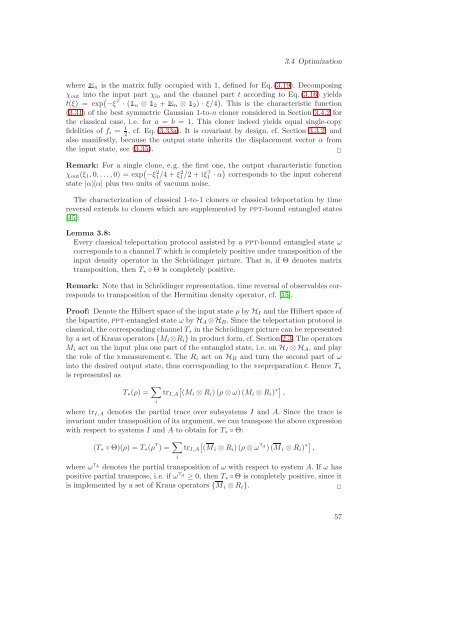Quantum Information Theory with Gaussian Systems
Quantum Information Theory with Gaussian Systems
Quantum Information Theory with Gaussian Systems
Create successful ePaper yourself
Turn your PDF publications into a flip-book with our unique Google optimized e-Paper software.
3.4 Optimization<br />
wheren is the matrix fully occupied <strong>with</strong> 1, defined for Eq.(3.19). Decomposing<br />
χout into the input part χin and the channel part t according to Eq.(3.16) yields<br />
t(ξ) = exp −ξ T · ( n ⊗ 2 +n ⊗ 2) · ξ/4 . This is the characteristic function<br />
(3.31) of the best symmetric <strong>Gaussian</strong> 1-to-n cloner considered in Section 3.4.2 for<br />
the classical case, i.e. for a = b = 1. This cloner indeed yields equal single-copy<br />
fidelities of fi = 1<br />
2<br />
, cf. Eq.(3.33a). It is covariant by design, cf. Section 3.3.2, and<br />
also manifestly, because the output state inherits the displacement vector α from<br />
the input state, see (3.35). <br />
Remark: For a single clone, e.g. the first one, the output characteristic function<br />
χout(ξ1, 0, . . .,0) = exp −ξ2 1 /4 + ξ2 1 /2 + iξT 1 · α corresponds to the input coherent<br />
state |α〉〈α| plus two units of vacuum noise.<br />
The characterization of classical 1-to-1 cloners or classical teleportation by time<br />
reversal extends to cloners which are supplemented by ppt-bound entangled states<br />
[45]:<br />
Lemma 3.8:<br />
Every classical teleportation protocol assisted by a ppt-bound entangled state ω<br />
corresponds to a channel T which is completely positive under transposition of the<br />
input density operator in the Schrödinger picture. That is, if Θ denotes matrix<br />
transposition, then T∗ ◦ Θ is completely positive.<br />
Remark: Note that in Schrödinger representation, time reversal of observables corresponds<br />
to transposition of the Hermitian density operator, cf. [15].<br />
Proof: Denote the Hilbert space of the input state ρ by HI and the Hilbert space of<br />
the bipartite, ppt-entangled state ω by HA ⊗HB. Since the teleportation protocol is<br />
classical, the corresponding channel T∗ in the Schrödinger picture can be represented<br />
by a set of Kraus operators {Mi⊗Ri} in product form, cf. Section 2.3. The operators<br />
Mi act on the input plus one part of the entangled state, i.e. on HI ⊗ HA, and play<br />
the role of themeasurement. The Ri act on HB and turn the second part of ω<br />
into the desired output state, thus corresponding to therepreparation. Hence T∗<br />
is represented as<br />
T∗(ρ) = <br />
i<br />
<br />
trI,A (Mi ⊗ Ri)(ρ ⊗ ω)(Mi ⊗ Ri) ∗ ,<br />
where trI,A denotes the partial trace over subsystems I and A. Since the trace is<br />
invariant under transposition of its argument, we can transpose the above expression<br />
<strong>with</strong> respect to systems I and A to obtain for T∗ ◦ Θ:<br />
(T∗ ◦ Θ)(ρ) = T∗(ρ T<br />
) = <br />
i<br />
<br />
trI,A (Mi ⊗ Ri)(ρ ⊗ ω TA )(Mi ⊗ Ri) ∗ ,<br />
where ω T A denotes the partial transposition of ω <strong>with</strong> respect to system A. If ω has<br />
positive partial transpose, i.e. if ω T A ≥ 0, then T∗ ◦ Θ is completely positive, since it<br />
is implemented by a set of Kraus operators {Mi ⊗ Ri}. <br />
57
















